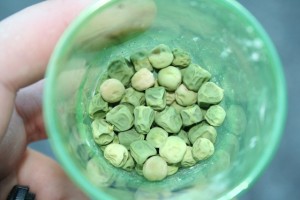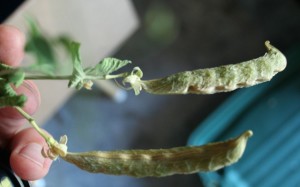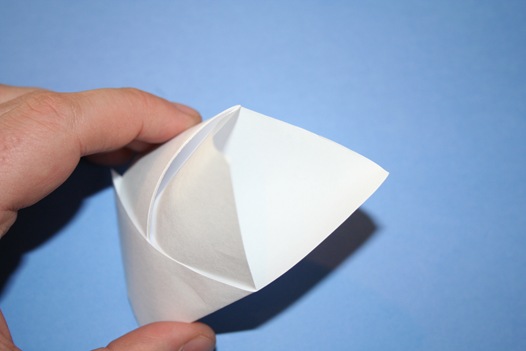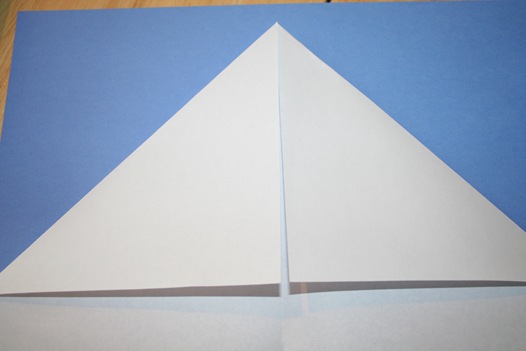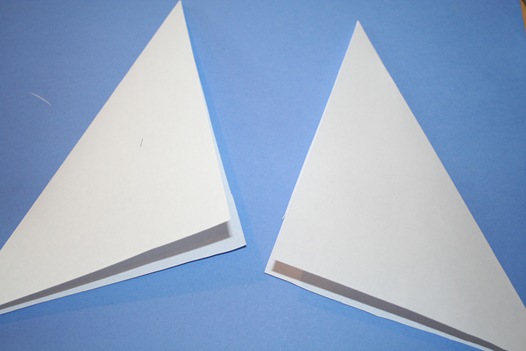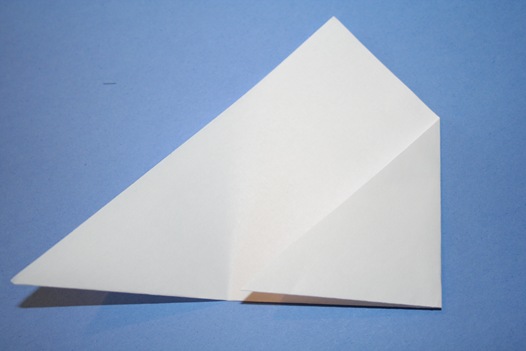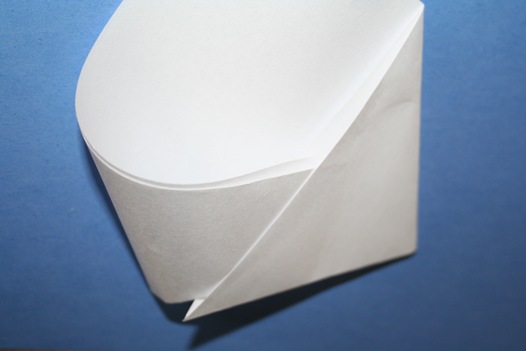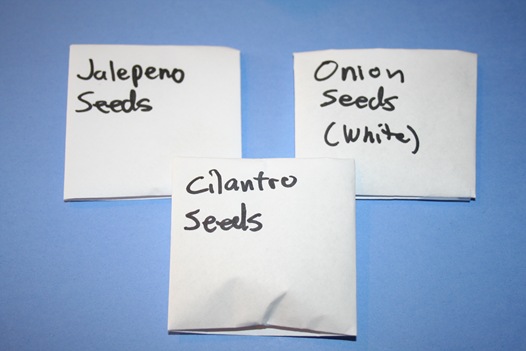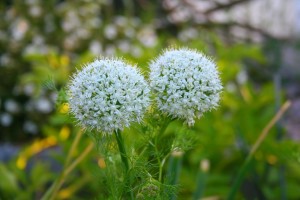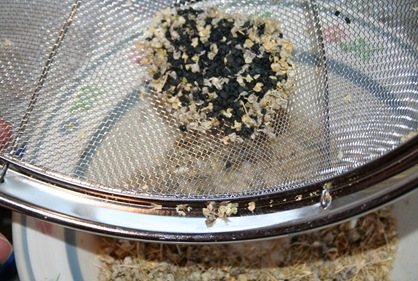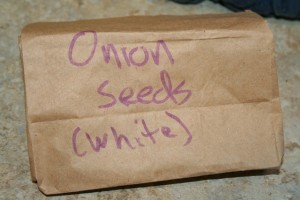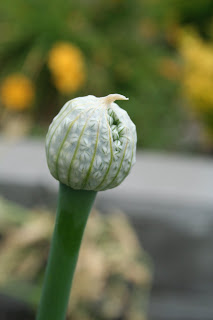How to save pea seeds from your garden
14.8 years ago harvest, peas, seed saving, seed storing, seeds
Most of the seeds I purchase, I am able to keep for at least a few seasons before running out. The one exception to this rule is peas, which I always have to buy each season. To save myself a couple dollars next year after I had my fill of peas from my garden I let quite a few mature which I will reuse for seeds this fall and next spring.
Out of all the seeds I have collected peas definitely are the easiest by far. If you want to go with the ultra lazy easy approach just let them dry on the vine until the pod no longer has any moisture and the peas are loose in the pod. You even can store them in the pod and crack them open for planting. One disadvantage to this technique is the peas could end up getting enough airflow and could result in some moldy peas.
To be on the safer side here is a more conservative approach:
- Pick pods when fine is yellow. The basic idea at this point the plant is not really providing anything to the pods so you might as well take on the responsibility
- If the pod still feels a little moist store it in a dry location. If the pod feels dry using a small knife carefully cut a small slit lengthwise into the pod being careful to not to injure the peas.
- Once the peas get all shrived up and look like what you planted to begin with store in a cold dry location (jar in the refrigerator)
Now you have seeds ready for fall planting (or spring planting next year) If you go a little crazy with your dried peas you can also add them to soups or stews during the winter time.
Tags: garden seeds, outdoor plants
Make your own paper seed packets (origami)
15.4 years ago seed saving, seed storing
When I posted about my adventures in saving onion seeds I mentioned the desire to purchase some small envelopes to hold the seeds. jimmycrackedcorn promptly responded with a comment scolding me for my lack of cheapness. Which I shamefully have to agree completely and took his advice and decided to make some of my own.
I followed the directions from the ICPS Seed Bank though I did do a little improvising to make the packets a little smaller and I got lazy on my folding so I have provided the cheap/lazy directions below.
Step #1: Start with a sheet of paper and fold down the middle, this will allow two seed packets per sheet of paper:
Step #2: Use scissors to cut out the individual triangles which will be come your seed packets
Step #3: Fold one corner one third of the way across the paper
Step #4: Insert the other corner inside the fold and fold flat
Step #5: Open top and pour in seeds, add a label, and fold over top
I like this design since it is easy enough that even I can do it, it naturally has a funnel to pour in/out seeds, and is fairly compact which is good since my pickle jar seed holder in my refrigerator is getting pretty full.
Tags: cheap, garden seeds, outdoor plants, vegetables
How to collect and save onion seeds from your garden
15.4 years ago onions, seed saving, seed storing
Last year I collected cilantro seeds and they were a great success in my garden that this past Spring I made a commitment to myself that I would try to collect more seeds this season. Though I wanted to get more I was able to collect seeds from my onions, jalapenos, and cilantro. The jalapeno seeds were pretty easy I set some seeds aside on a paper towel while making some salsa. After they appeared to be dry I threw them in a brown paper lunch bag.
For the onions once the florets (flower balls you see above) got real ugly and dry and I could see the black seeds emerging I placed them in a paper bag before the birds got to them. I then put the bag on top of our kitchen cabinets and forgot about them for couple months. Today I pulled the bag down and confirmed they definitely were dry. To separate the seeds from the pods I broke apart (which happens easily) and placed the contents into a metal strainer. I gently broken open any remaining pods and agitate the strainer. This causes the small black seeds to move to the bottom, allowing the pods to float to the top and forcing many of the stems to fall through.
I then skimmed off as many of the stems/pods as possible leaving and putting the seeds into a brown paper bag until I can get into town to buy some more manageably sized brown envelopes (recovering from Seattle snowstorm)
After a few minutes of work I now have hundreds of onions seeds which I probably only have use for couple dozen. Seed exchange anyone?
Tags: birds, cheap, cilantro, garden seeds, led, salsa garden, vegetables
How to save onion seeds from the garden
15.9 years ago onions, seed saving, seed storing
In the past I have harvested seeds for cilantro which worked so well I have decided to try more this year. Now my gigantic onions are producing seed stalks and umbels are beginning to open seems like a good time to try harvesting my own onion seeds.
To save these seeds it is pretty simple, when the umbels have dried out and begin to open. At this time carefully cut them off (making sure that seeds do not fall) and place in a them in a cool dry location for 2-3 weeks. I prefer to put my harvest seeds in the refrigerator in a paper bag. It is a good idea for onions to cross pollinate so I will plan on buying some other onion seeds to mix with the ones I am harvesting to allow for cross pollination.
Onions take 100-120 days from seed to maturity, if you start from sets which you grow from the previous year can shave 3-4 weeks off that time. I could make my own onion sets by planting 30-40 seeds in a square foot area during late summer. After two months rake over the tops and let them turn brown and dry out then store them in a dry place until next spring.
My PC grow box will be empty 10 weeks before my last frost date so planning on starting my onion seeds in there moving them outside 4 weeks before the last frost.
If you want to learn more about saving seeds for onions or other vegetables be sure to check out International Seed Saving Institute which has great advice about saving seeds from dozens of different plants.
Tags: cheap, cilantro, garden seeds, growbox, outdoor plants, vegetables
Planting seeds outside
16.1 years ago germination, outdoor seed starting, seed storing
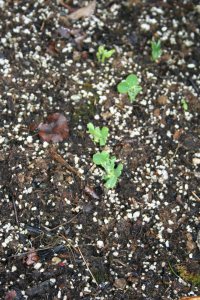
I always enjoy any seeds I required to start outdoors since they normally thrive with little effort from myself other than the occasional watering and given I live in the rainy Seattle area that does start until mid-June. Even if you have started many of your seeds indoors to extend your growing season some seeds should always start outdoors since they are sensitive to transplant shock. If you have been to a garden center or nursery lately you can get an idea by what types of plants can be transplanted easily. If you are now looking at your seed packets wondering if you should plant these indoors or outdoors here are my suggestions:
Plants that can be started indoors:
Broccoli, Cabbage, Cauliflower, Celery, Cucumbers, Cukes, Eggplant, Herbs, Kale, Leeks, Lettuce, Muskmelons, Onions (seed), Parsley, Peppers, Swiss Chard, Summer squash, Tomatoes, Zucchini
Plants that should be started outdoors:
Beans, Beets, Carrots, Cilantro, Corn, Cucumbers, Garlic, Muskmelons, Onions (sets), Peas, Potatoes, Radishes, Scallions, Spinach, Turnips, and Winter/Summer squash
You can see from the list there are some plants on both lists which shows that it is definitely possible to transplant some of these sensitive plants, but if you want to avoid the hassle and avoid killing a few plants without requiring surgical precision I would recommend opting for the direct seed planting approach.
Hopefully now you have an idea what you can plant so now comes how to actually do it. Your seed package which will normally give instructions something along the lines of planting the whole package of seeds in a row and thin out to the appropriate spacing. This has been the basic method that many gardeners have been doing for years. This normally leads to thinning 70% of the seedlings or so of the row, which is time consuming and since you can save seeds over a few years this method will definitely be more costly. To avoid this, I plant 1-2 seeds at the proper spacing, if the seeds have been saved for a couple years I add a couple extra seeds since even with proper seed storage the germination rates can decrease over time. After a week or two I simply thin the weakest of the seedlings by chopping them off with a small pair of scissors being careful to not disturb the seedling next to it. If you want to give your larger seeds a little head start, try soaking them in lukewarm water (add inoculants if they are in legume family) overnight before planting them.
Following these steps you should have some great activity in your garden with minimal maintenance and cost.
Tags: cheap, cilantro, garden seeds, garlic bulbs, herb garden, outdoor plants, pepper plants, tomato plants, vegetables
Growing Challenge: Planting the seeds
16.2 years ago growing challenge, seed storing
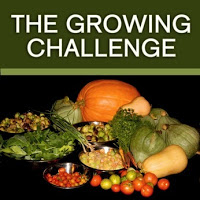
I have decided to participate in The Growing Challenge hosted by the people at Elements in Time. The short version is to try growing at least one thing from seed that you have not tried before.
My daughters and I have decided to grow some tomatoes (Sweetie, San Marzano, Siletz) which I normally pick from the limited choice of seedlings that are available at my garden store. While picking seeds my 3 year old insisted on getting corn, don’t think we have the space for it to be productive, guess in the end we might have some nice Halloween decorations. We also noticed that some of our potatoes had started to sprout so we have decided to add them to our list.
Stay tuned for updates on our growing challenge.
Tags: garden seeds, outdoor plants, tomato plants
